Coins
American Gold Eagle
The American Gold Eagle is an official gold bullion coin of the United States. Authorized under the Gold Bullion Coin Act of 1985, it was first released by the United States Mint in 1986. Because the term “eagle” also is the official United States designation for pre-1933 ten dollars gold coins, the weight of the bullion coin is typically used when describing American Gold Eagles (e.g., “1/2-ounce American Gold Eagle”) to avoid confusion. This is particularly true with the 1/4-oz American Gold Eagle, which has a marked face value of ten dollars.
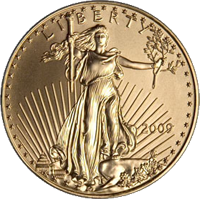
Offered in 1/10 oz, 1/4 oz, 1/2 oz, and 1 oz denominations, these coins are guaranteed by the U.S. government to contain the stated amount of actual gold weight in troy ounces. By law, the gold must come from sources in America, alloyed with silver and copper to produce a more wear-resistant coin.
The 22 kt gold alloy is an English standard traditionally referred to as “crown gold”. Crown gold alloys had not been used in U.S. coins since 1834, with the gold content having dropped since 1837 to a standard of 0.900 fine for U.S. gold coins. For American Gold Eagles the gold fraction was increased again to .9167 or (22 karat). It is authorized by the United States Congress and is backed by the United States Mint for weight and content.
The obverse design features a rendition of Augustus Saint-Gaudens’ full length figure of Lady Liberty with flowing hair, holding a torch in her right hand and an olive branch in her left, with the Capitol building in the left background. The design is taken from the $20 Saint-Gaudens gold coin which was commissioned by Theodore Roosevelt to create coins like the ancient Greek and Roman coins. The reverse design, by sculptor Miley Busiek, features a male eagle carrying an olive branch flying above a nest containing a female eagle and her hatchlings.
Value
The market value of the coins is generally about equal to the market value of their gold content, not their face value. Like all commodities, this value fluctuates with market forces. The face values are proportional to the weights except for the 1/4 oz coin. Their actual selling prices vary based on the current spot price of gold. The United States Mint also produces proof and uncirculated versions for coin collectors. These coins are produced at the West Point Mint in West Point, New York. The proof and uncirculated versions carry the mint’s mark (“W”) beneath the date.
Canadian Gold Maple Leaf
The Canadian Gold Maple Leaf (GML) is a gold bullion coin that is issued annually by the Government of Canada. It is produced by the Royal Canadian Mint.
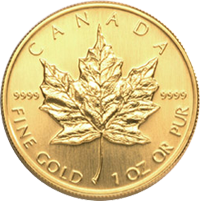
The Gold Maple Leaf is legal tender with a face value of 50 Canadian dollars. The market value of the metal varies, depending on the spot price of gold. Having a .9999 millesimal fineness (24 carats), in some cases .99999, the coin is among the purest official bullion coins worldwide. The standard version has a weight of minimum 1 troy ounce (31.10 grams). Other sizes and denominations include 1 gram, 1⁄25 oz. ($0.50), 1⁄20 oz. ($1), 1⁄10 oz. ($5), 1⁄4 oz. ($10), and 1⁄2 oz. ($20).
The Gold Maple Leaf’s obverse and reverse display, respectively, the profile of Queen Elizabeth II of Canada and the Canadian Maple Leaf. In 2013 and 2015 new security features were introduced. In 2013, a laser-micro-engraved textured maple leaf was added on a small area of the reverse (Maple Leaf) side of the coin. In the center of this mark is the numeral denoting the coin’s year of issue, which is only visible under magnification. In 2015, the radial lines on the coin’s background on both sides of the coin were added.
On 3 May 2007, the Royal Canadian Mint unveiled a Gold Maple Leaf coin with a nominal face value of $1 million and a metal value of over $3.5 million.[2][3] It measures 50 cm in diameter by 3 cm thick and has a mass of 100 kg, with a purity of 99.999%. The artist is Stanley Witten. On March 26, 2017 one of the five copies with a gold value of 4 million US$ was stolen from the Bode Museum.
American Silver Eagle
The American Silver Eagle is the official silver bullion coin of the United States.
It was first released by the United States Mint on November 24, 1986. It is struck only in the one-troy ounce size, which has a nominal face value of one dollar and is guaranteed to contain one troy ounce of 99.9% pure silver. It is authorized by Title II of Public Law 99-61 (Liberty Coin Act, approved July 9, 1985) and codified as 31 U.S.C. § 5112(e)-(h). Its content, weight, and purity are certified by the United States Mint. In addition to the bullion version, the United States Mint has produced a proof version and an uncirculated version for coin collectors. The Silver Eagle has been produced at three mints: the Philadelphia Mint, the San Franc
isco Mint, and the West Point Mint. The American Silver Eagle bullion coin may be used to fund Individual Retirement Account investments.
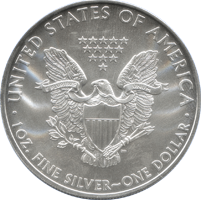
Design
The design on the coin’s obverse was taken from the “Walking Liberty” design by Adolph A. Weinman, which originally had been used on the Walking Liberty Half Dollar coin of the United States from 1916 to 1947. As this iconic design had been a public favorite—and one of the most beloved designs of any United States coinage of modern times, silver or otherwise—it was revived for the Silver Eagle decades later. The obverse is inscribed with the year of minting or issuance, the word LIBERTY, and the phrase IN GOD WE TRUST.
The reverse was designed by John Mercanti and portrays a heraldic eagle behind a shield; the eagle grasps an olive branch in its right talon and arrows in its left talon, echoing the Great Seal of the United States; above the eagle are thirteen five-pointed stars representing the Thirteen Colonies.[2] The reverse is inscribed with the phrases UNITED STATES OF AMERICA, 1 OZ. FINE SILVER~ONE DOLLAR, and E PLURIBUS UNUM (on the banner that the eagle holds in its beak), as well as the mintmark if applicable.
Saint-Gaudens Double Eagle
The Saint-Gaudens double eagle is a twenty-dollar gold coin, or double eagle, produced by the United States Mint from 1907 to 1933. The coin is named after its designer, the sculptor Augustus Saint-Gaudens, who designed the obverse and reverse. It is considered by many to be the most beautiful of U.S. coins.
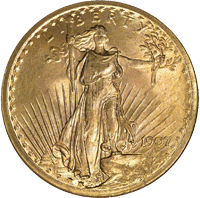
In 1904, President Theodore Roosevelt sought to beautify American coinage, and proposed Saint-Gaudens as an artist capable of the task. Although the sculptor had poor experiences with the Mint and its chief engraver, Charles E. Barber, Saint-Gaudens accepted Roosevelt’s call. The work was subject to considerable delays, due to Saint-Gaudens’s declining health and difficulties because of the high relief of his design. Saint-Gaudens died in 1907, after designing the eagle and double eagle, but before the designs were finalized for production.
After several versions of the design for the double eagle proved too difficult to strike, Barber modified Saint-Gaudens’s design, lowering the relief so the coin could be struck with only one blow. When the coins were finally released, they proved controversial as they lacked the words “In God We Trust”, and Congress intervened to require the motto’s use. The coin was minted, primarily for use in international trade, until 1933. The 1933 double eagle is among the most valuable of U.S. coins, with the sole example currently known to be in private hands selling in 2002 for $7,590,020.
Liberty Gold Eagle
A double eagle is a gold coin of the United States with a denomination of $20. (Its gold content of 0.9675 troy oz (30.0926 grams) was worth $20 at the 1849 official price of $20.67/oz.) The coins are made from a 90% gold (0.900 fine = 21.6 kt) and 10% copper alloy and have a total weight of 1.0750 troy ounces (33.4362 grams).
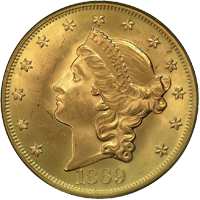
The “eagle”, “half eagle”, and “quarter eagle” were specifically given these names in the Act of Congress that originally authorized them (“An act establishing a mint, and regulating coins of the United States”, section 9, April 2, 1792). Likewise, the double eagle was specifically created as such by name (“An act to authorize the coinage of gold dollars and double eagles”, title and section 1, March 3, 1849).
The first double eagle was minted in 1849, coinciding with the California Gold Rush. In that year, the mint produced two pieces in proof. The first resides in the Smithsonian Institution in Washington, D.C. The second was presented to Treasury Secretary William M. Meredith and was later sold as part of his estate—the present location of this coin remains unknown.
In 1850, regular production began and continued until 1933 (when the official price of gold was changed to $35/oz by the Gold Reserve Act). Prior to 1850, eagles with a denomination of $10 were the largest denomination of US coin. The $10 eagles were produced beginning in 1795, just two years after the first U.S. mint opened. Since the $20 gold piece had twice the value of the eagle, these coins were designated “double eagles”.
Silver Morgan
The Morgan dollar was a United States dollar coin minted from 1878 to 1904, and again in 1921. It was the first standard silver dollar minted since production of the previous design, the Seated Liberty dollar, ceased due to the passage of the Coinage Act of 1873, which also ended the free coining of silver. The coin is named after its designer, United States Mint Assistant Engraver George T. Morgan. The obverse depicts a profile portrait representing Liberty, while the reverse depicts an eagle with wings outstretched.
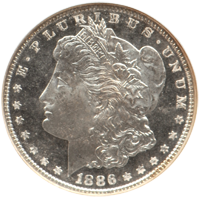
The dollar was authorized by the Bland–Allison Act. Following the passage of the 1873 act, mining interests lobbied to restore free silver, which would require the Mint to accept all silver presented to it and return it, struck into coin. Instead, the Bland–Allison Act was passed, which required the Treasury to purchase between two and four million dollars’ worth of silver at market value to be coined into dollars each month. In 1890, the Bland–Allison Act was repealed by the Sherman Silver Purchase Act, which required the Treasury to purchase 4,500,000 troy ounces (140,000 kg) of silver each month, but only required further silver dollar production for one year. This act, once again, was repealed in 1893.
In 1898, Congress approved a bill that required all remaining bullion purchased under the Sherman Silver Purchase Act to be coined into silver dollars. When those silver reserves were depleted in 1904, the Mint ceased to strike the Morgan dollar. The Pittman Act, passed in 1918, authorized the melting and recoining of millions of silver dollars. Pursuant to the act, Morgan dollars resumed mintage for one year in 1921. The design was replaced by the Peace dollar later the same year.
In the early 1960s, a large quantity of uncirculated Morgan dollars in their original bags were discovered in the Treasury vaults, including issues once thought rare. Individuals began purchasing large quantities of the pieces at face value, and eventually the Treasury ceased exchanging silver certificates for silver coin. Beginning in the 1970s, the Treasury conducted a sale of silver dollars minted at the Carson City Mint through the General Services Administration. In 2006, Morgan’s reverse design was used on a silver dollar issued to commemorate the old San Francisco Mint building.
Request Your FREE Metals Guide
Understand the advantages of adding Precious Metals to your IRA or taking Physical Possesion.

Gold Products
Silver Products
Knowledge Center
Contact Us
American Gold Metals
2625 Towngate Road Suite 330
Westlake Village, Ca 91361
Phone: 800-528-0545
Fax: 818-712-0336





